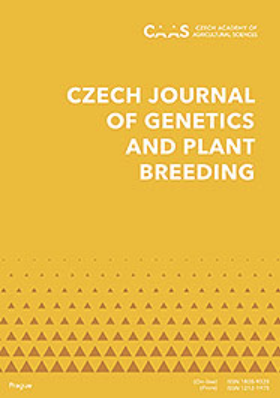小麦抗枯萎病育种研究进展
IF 1.8
4区 农林科学
Q3 AGRONOMY
引用次数: 2
摘要
禾谷镰刀菌(Fusarium graminearum)是全球最具破坏性的小麦病害之一。FHB通过被镰刀菌毒素如脱氧雪腐镰刀菌烯醇(DON)、T2毒素、HT-2毒素、雪腐镰刀菌烯醇和玉米赤霉烯酮污染,导致产量大幅度下降,并降低粮食质量。综述了FHB抗性遗传研究的最新进展,重点介绍了FHB的抗性来源、抗性基因/数量性状位点(QTL)挖掘、抗性基因克隆、主要FHB抗性基因/分子标记QTL鉴定以及抗性机制。综述了基于表型选择和分子标记的抗性育种的研究成果。在系统分析FHB抗性材料的育种局限性和利用情况的基础上,作者提出了三点建议:首先,为了加强小麦的抗性鉴定,由于视觉症状不太可靠,需要特别注意镰刀菌损伤籽粒和DON等性状的检测,应推广抗性品种,加强抗性基因的筛选;二是利用现有品种积累的数量抗性基因的加性效应,降低抗性成本,创造高产抗性品种。第三,加强新基因的研究和利用。本文章由计算机程序翻译,如有差异,请以英文原文为准。
Advances in wheat breeding for resistance to Fusarium head blight
Fusarium head blight (FHB), mainly caused by Fusarium graminearum, is one of the most devastating diseases of wheat globally. FHB causes an extensive reduction in yield and reduces the grain quality through its contamination with Fusarium toxins such as deoxynivalenol (DON), T2 toxin, HT-2 toxin, nivalenol, and zearalenone. This review provides an overview of updated progress of genetic studies on the resistance to FHB, with an emphasis on the sources of resistance to FHB, resistance gene/quantitative trait loci (QTL) mining, resistance gene cloning, major FHB resistance genes/QTL identification by molecular markers, and resistance mechanisms. The achievements of resistance breeding based on phenotype selection and molecular markers was also summarised. Based on the systematic analysis of breeding limitations and utilisation of FHB resistant materials, the authors put forward three suggestions: First, to toughen the resistance identification of wheat, testing traits such as Fusarium damaged kernel and DON need special attention as visual symptoms are less reliable, resistant varieties should be popularised, and the screening the resistant genes should be strengthened; The second is to use the additive effect of quantitative resistance genes accumulated from existing varieties to reduce the cost of resistance in order to create high yielding resistant varieties. Thirdly, to enhance research and utilization of new genes.
求助全文
通过发布文献求助,成功后即可免费获取论文全文。
去求助
来源期刊

Czech Journal of Genetics and Plant Breeding
Agricultural and Biological Sciences-Plant Science
CiteScore
2.20
自引率
0.00%
发文量
25
审稿时长
>12 weeks
期刊介绍:
Original scientific papers, critical reviews articles and short communications from the field of theoretical and applied plant genetics, plant biotechnology and plant breeding. Papers are published in English.
 求助内容:
求助内容: 应助结果提醒方式:
应助结果提醒方式:


